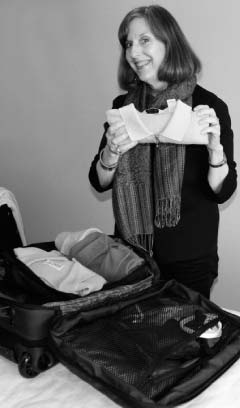Tourist Information
Tourist Offices
Communicating
Telephones
Internet Access
Mail
Transportation
By Car or Public Transportation?
Public Transportation
Map: Ireland Public Transportation
Renting a Car
Map: Driving in Ireland
Driving
Cheap Flights
Resources
Resources from Rick Steves
Maps
Other Guidebooks
Recommended Books and Movies
Holidays and Festivals
Conversions and Climate
Numbers and Stumblers
Metric Conversions (Approximate)
Clothing Sizes
Ireland’s Climate
Temperature Conversion: Fahrenheit and Celsius
Ireland’s national tourist office in the US—called Tourism Ireland—offers a wealth of information on both the Republic of Ireland and Northern Ireland. Before your trip, scan their website (www.discoverireland.com) and download brochures and maps. You can ask questions and request that information be mailed to you (such as the free vacation planning packet, regional and city maps, walking routes, and festival schedules) by emailing info.us@tourismireland.com, or calling 800-SHAMROC (US tel. 800-742-6762).
In Ireland, your best first stop in every town is generally the tourist information office—abbreviated TI in this book. TIs are good places to get a city map and information on public transit (including bus and train schedules), walking tours, special events, and nightlife. Many TIs have information on the entire country or at least the region, so try to pick up maps for destinations you’ll be visiting later in your trip. If you’re arriving in town after the TI closes, call ahead or pick up a map in a neighboring town.
In Dublin, try to get everything you’ll need for all of Ireland in one stop at the TI in the old church on Suffolk Street (see here). The general nationwide tourist-information phone number for travelers calling from within Ireland is 1-850-230-330 (and their nationwide room-booking phone number is 1-800-363-626; office open Mon-Sat 9:00-20:00, closed Sun).
For all the help TIs offer, unless you’re in a bind steer clear of their room-finding services (bloated prices, no opinions, and you have to pay 15 percent upfront to the TI).
Smart travelers use the telephone to reserve or reconfirm rooms, get tourist information, reserve restaurants, confirm tour times, or phone home. This section covers dialing instructions, phone cards, and types of phones you’ll encounter (for more in-depth information, see www.ricksteves.com/phoning).
How to Dial
Calling from the US to Ireland, or vice versa, is simple—once you break the code. The European calling chart later in this chapter will walk you through it.
Dialing Domestically Within Ireland
The following instructions apply whether you’re dialing from a landline (such as a pay phone or your hotel-room phone) or an Irish mobile phone.
Ireland, like much of the US, uses an area-code dialing system. To make domestic calls, if you’re dialing from within an area code, you just dial the local number to be connected; but if you’re calling from outside an area code, you have to dial both the area code (which starts with a 0) and the local number. For example, to call the recommended Harding Hotel in Dublin within Dublin, you’d dial 679-6500. To call it from Galway, you’d dial 01-679-6500.
Area codes are listed in this book, and are available from directory assistance (dial 11811 in the Republic, 192 in Northern Ireland).
The Republic of Ireland has a special way to call Northern Ireland: dial 048, and then the local number without the area code. For instructions on how to call the Republic of Ireland from Northern Ireland, see below.
If you’re dialing within Ireland using your US mobile phone, you may need to dial as if you’re making a domestic call, or you may need to dial as if you’re calling from the US (see “Dialing Internationally,” next). Try it one way, and if that doesn’t work, try it the other way.
Dialing Internationally to or from Ireland
To make an international call, follow these steps:
• Dial the international access code (00 if you’re calling from Europe, 011 from the US or Canada). If you’re dialing from a mobile phone, you can replace the international access code with +, which works regardless of where you’re calling from. (On many mobile phones, you can insert a + by pressing and holding the 0 key.)
• Dial the country code of the country you’re calling (353 for the Republic of Ireland, 44 for Northern Ireland, or 1 for the US or Canada).
• Dial the area code (Dublin’s area code is 01) and the local number, keeping in mind that if you’re calling Ireland, drop the initial zero of the area code. (For specifics per country, see the European calling chart in this chapter.)
Calling from the US to the Republic of Ireland: To call the recommended Harding Hotel in Dublin from the US, dial 011 (US access code), 353 (the Republic of Ireland’s country code), 1 (Dublin’s area code without its initial 0), and then 679-6500 (the hotel’s number).
Calling from any European country—including Northern Ireland—to the Republic of Ireland: Dial 00-353, then the area code without its initial 0, and then the local number.
From the US or Canada to Northern Ireland: Dial 011-44-28 (44 is the country code for the United Kingdom; 28 is Northern Ireland’s area code without its initial 0), and then the local number.
From the Republic of Ireland to Northern Ireland: Dial 048, and then the local number. (In this case, you omit Northern Ireland’s area code, 028, entirely.)
From any European country (except the Republic of Ireland) to Northern Ireland: Dial 00-44-28 (Northern Ireland’s area code without its initial 0), and then the local number.
From anywhere in Ireland (Republic and Northern Ireland) to the US: To call from Ireland to my office in Edmonds, Washington, I dial 00 (Ireland’s access code), 1 (US country code), 425 (Edmonds’ area code), and 771-8303.
Mobile Phones
Traveling with a mobile phone is handy and practical. There are two basic options: roaming with your own phone (expensive but easy) or buying and using SIM cards with an unlocked phone (a bit more hassle, but potentially much cheaper).
Roaming with Your US Mobile Phone: This pricier option can be worthwhile if you won’t be making or receiving many calls, don’t want to bother with SIM cards, or want to stay reachable at your US number. Start by calling your mobile-phone service provider to ask whether your phone works in Europe and what the rates are (likely $1.29-1.99 per minute to make or receive calls, and 20-50 cents to send or receive text messages). Tell them to enable international calling on your account, and if you know you’ll be making multiple calls, ask your carrier about any global calling deals to lower the per-minute costs. When you land in Europe, turn on your phone and—bingo!—you have service. Because you’ll pay for receiving calls and texts, be sure your family knows to call only in an emergency. Note that Verizon and Sprint use a different technology than European providers, so their phones are less likely to work abroad; if yours doesn’t, your provider may be able to send you a loaner phone (arrange in advance).
Buying and Using SIM Cards in Europe: If you’re comfortable with mobile-phone technology, will be making lots of calls, and want to save some serious money, consider this very affordable alternative: Carry an unlocked mobile phone, and use it with a European SIM card to get much cheaper rates.
Getting an unlocked phone may be easier than you think. You may already have an old, unused mobile phone in a drawer somewhere. When you got the phone, it was probably “locked” to work only with one company—but if your contract is now up, your provider may be willing to send you a code to unlock it. Just call and ask. Otherwise, you can simply buy an unlocked phone: Search your favorite online shopping site for an “unlocked quadband phone” before you go, or wait until you get to Europe and buy one at a mobile-phone shop there. Either way, a basic model costs less than $50.
Once in Europe, buy a SIM card—the little chip that inserts into your phone (either under the battery, or in a slot on the side)—to equip the phone with a European number. (Note that smaller “micro-SIM” or “nano-SIM” cards—used in some iPhones—are less widely available.) SIM cards are sold at mobile-phone shops, department-store electronics counters, and some newsstand kiosks for $5-10, and usually include about that much prepaid calling credit (making the card itself virtually free). In most places, buying a SIM card is as easy as buying a pack of gum—and almost as cheap. (In some countries—including Italy, Germany, and Hungary—it can take a bit longer, because you have to show your passport and be registered.) Because SIM cards are prepaid, there’s no contract and no commitment (in fact, they expire after just a few months of disuse); I buy one even if I’m in a country for only a few days.
When using a SIM card in its home country, it’s free to receive calls and texts, and it’s cheap to make calls—domestic calls average 20-30 cents per minute (though toll lines can be substantially more). Rates are higher if you’re roaming in another country, but as long as you stay within the European Union, these fees are capped (about 30 cents per minute for making calls or 10 cents per minute for receiving calls). Texting is cheap even if roaming in another country. Particularly inexpensive SIM card brands let you call either within Europe or to the US for less than 10 cents per minute.
When purchasing a SIM card, always ask about fees for domestic and international calls, roaming charges, and how to check your credit balance and buy more time. If text or voice prompts are in another language, ask the clerk whether they can be switched to English.
It’s also possible to buy an inexpensive mobile phone in Europe that already comes with a SIM card. While these phones are generally locked to work with just one provider (and therefore can’t be reused on future trips), they may be less hassle than buying an unlocked phone and a SIM card separately.
On my last visit to Ireland, I bought a cheap and durable locked €30 phone from Vodafone (www.vodafone.ie) as soon as I arrived. These basic phones can only make and receive calls, and send and receive text messages. They usually come preloaded with €10 of phone time. When necessary, I could “top up” (add more phone time) at mini-markets, magazine shops, or other Vodafone stores in Ireland.
Mobile-Phone Calling Apps: If you have a smartphone, you can use it to make free or cheap calls in Europe by using a calling app such as Skype or FaceTime when you’re on Wi-Fi; for details, see the next section.
Calling over the Internet
Some things that seem too good to be true...actually are true. If you’re traveling with a smartphone, tablet, or laptop, you can make free calls over the Internet to another wireless device, anywhere in the world, for free. (Or you can pay a few cents to call from your computer or smartphone to a telephone.) The major providers are Skype, Google Talk, and (on Apple devices) FaceTime. You can get online at a Wi-Fi hotspot and use these apps to make calls without ringing up expensive roaming charges (though call quality can be spotty on slow connections). You can make Internet calls even if you’re traveling without your own mobile device: Many European Internet cafés have Skype, as well as microphones and webcams, on their terminals—just log on and chat away.
Landline Telephones
Just like Americans, these days most Europeans make the majority of their calls on mobile phones. But you’ll still encounter landlines in hotel rooms and at pay phones.
Hotel-Room Phones: Calling from your hotel room (in-room phones are rare in B&Bs) can be great for local calls and for international calls if you have an international phone card (described later). Otherwise, hotel-room phones can be an almost criminal rip-off for long-distance or international calls. Many hotels charge a fee for local and sometimes even “toll-free” numbers—always ask for the rates before you dial.
Public Pay Phones: Coin-op phones are becoming extinct in Europe. To make calls from public phones, you’ll need a prepaid phone card, described next.
Telephone Cards
There are two types of phone cards: insertable (for pay phones) and international (cheap for overseas calls and usable from any type of phone). Both types of phone card work only within the country of purchase, with the exception of some brands of cards that are usable in both the Republic of Ireland and the UK—confirm before buying a card by checking for both an 1800 access number (used in the Republic of Ireland) and an 0800 access number (for the UK—don’t use the 0845, 0870, or 0871 numbers, which cost about 10p per minute). If you have a live card at the end of your trip, give it to another traveler to use—most cards expire 3-6 months after the first use.
Insertable Phone Cards: This type of card can be used only at Irish pay phones. It’s handy and affordable for local and domestic calls, but more expensive for international calls. Telecom Éireann phone cards are sold for €5, €10, or €20 at newsstands, TIs, and post offices. To use the card, physically insert it into a slot in the pay phone. But be aware that phone booths are becoming scarcer, and those that remain are often out of order.
International Phone Cards: With these cards, phone calls from Ireland to the US can cost less than a nickel a minute. The cards can also be used to make local calls, and they work from any type of phone, including your hotel-room phone or a mobile phone with a European SIM card. To use the card, dial a local or toll-free access number, and then enter your scratch-to-reveal PIN code. Some hotels block their phones from accepting these access numbers. (Ask your hotelier about access and rates before you call.)
You can buy the cards at many post offices, newsstands, minimarts, and exchange bureaus. Ask the clerk which of the various brands has the best rates for calls to America. Buy a lower denomination in case the card is a dud. Since you don’t need the actual card or receipt to use the account, you can write down the access number and code and share it with friends.
US Calling Cards: These cards, such as the ones offered by AT&T, Verizon, and Sprint, are a rotten value and are being phased out. Try any of the options outlined earlier.
Useful Phone Numbers
Note that calls beginning with 1800 are free throughout Ireland, but 1850 calls cost the same as local calls.
Emergency Needs
Emergency (Police and Ambulance)
In the Republic of Ireland and Northern Ireland: Tel. 999
US Embassies and Consulates
In the Republic of Ireland: 42 Elgin Road, Dublin, Mon-Tue and Thu-Fri 8:30-11:30, closed Wed and Sat-Sun, tel. 01/668-7122 or 01/668-8777, http://dublin.usembassy.gov
In Northern Ireland: Danesfort House, 223 Stranmillis Road, Belfast, Mon-Fri 8:30-17:00, closed Sat-Sun, tel. 028/9038-6100, after-hours emergency mobile 075-4550-7738, http://belfast.usconsulate.gov
Canadian Embassies
In the Republic of Ireland: 7-8 Wilton Terrace, Dublin, Mon-Fri 9:00-13:00 & 14:00-16:30, consular and passport services open Mon-Fri 9:00-12:00, closed Sat-Sun, tel. 01/234-4000, www.canada.ie
In Northern Ireland: 9 Cromac Avenue, Belfast, tel. 028/9127-2060. This office does not offer passport services; instead contact the Canadian High Commission in London (www.unitedkingdom.gc.ca).
Travel Advisories
US Department of State: Tel. 888-407-4747, from outside US tel. 1-202-501-4444, www.travel.state.gov
Canadian Department of Foreign Affairs: Canadian tel. 800-387-3124, from outside Canada tel. 1-613-996-8885, www.travel.gc.ca
US Centers for Disease Control and Prevention: Tel. 800-CDC-INFO (800-232-4636), www.cdc.gov/travel
Directory Assistance
In the Republic of Ireland
Operator Assistance: Tel. 10 for Ireland, tel. 114 to call outside Ireland
Directory Assistance Within Ireland: Tel. 11811
International Info: Tel. 11818
In Northern Ireland
Operator Assistance: Tel. 100 for Britain, tel. 155 to call outside Britain
Directory Assistance Within Britain: Tel. 192 (20p from phone booth, otherwise £1.50)
International Info: Tel. 153 (20p from phone booth, otherwise £1.50)
Airlines
These are phone numbers for the Republic of Ireland.
Aer Lingus: Tel. 0818-365-000, www.aerlingus.com
Air Canada: Tel. 016-793-958, www.aircanada.com
Air France: Tel. 0818-776-057, www.airfrance.com
American: Tel. 0818-286-597, www.aa.com
Delta: Tel. 0818-904-872, www.delta.com
Iberia: Tel. 0818-462-000, www.iberia.com
Lufthansa: Tel. 01/844-5544, www.lufthansa.com
Ryanair (cheap fares): Tel. 1520-444-004, www.ryanair.com
Scandinavian Airlines System (SAS): Tel. 01/844-5440, www.flysas.com
Swiss Air: Tel. 1890-200-515, www.swiss.com
United: Tel. 1890-925-252, www.united.com
US Airways: Tel. 1890-925-065, www.usairways.com
Airports
Dublin (DUB): Tel. 01/814-1111, www.dublinairport.ie
Shannon (SNN): Tel. 061/712-000, www.shannonairport.ie
Cork (ORK): Tel. 021/431-3131, www.corkairport.com
Belfast: Belfast International Airport (BFS)—tel. 028/9448-4848, www.belfastairport.com; George Best Belfast City Airport (BHD)—tel. 028/9093-9093, www.belfastcityairport.com
Dublin Car-Rental Agencies
Avis: 35-39 Old Kilmainham Road, tel. 021/428-1111, airport tel. 01/605-7500, www.avis.ie
Hertz: 151 South Circular Road, tel. 01/676-7476, airport tel. 01/844-5466, www.hertz.ie
Budget: 151 Lower Drumcondra Road, tel. 01/837-9611, central reservations tel. 09066/27711, airport tel. 01/844-5150, www.budget.ie
Europcar: 2 Haddington Road, tel. 01/614-2888, airport tel. 01/812-0410, www.europcar.ie
It’s useful to get online periodically as you travel—to confirm trip plans, check train or bus schedules, get weather forecasts, catch up on email, blog or post photos from your trip, or call folks back home (explained earlier, under “Calling over the Internet”).
Your Mobile Device: The majority of accommodations in Ireland offer Wi-Fi, as do many cafés, making it easy for you to get online with your laptop, tablet, or smartphone. Access is often free, but sometimes there’s a fee. At hotels that charge for a certain number of hours, save money by logging in and out of your account on an as-needed basis. You should be able to stretch a two-hour Wi-Fi pass over a stay of a day or two.
Some hotel rooms and Internet cafés have high-speed Internet jacks that you can plug into with an Ethernet cable.
Public Internet Terminals: Many accommodations offer a computer in the lobby with Internet access for guests. If you ask politely, smaller places may let you sit at their desk for a few minutes just to check your email. If your hotelier doesn’t have access, ask to be directed to the nearest place to get online.
Security: Whether you’re accessing the Internet with your own device or at a public terminal, using a shared network or computer comes with the potential for increased security risks. If you’re not convinced a connection is secure, avoid accessing any sites (such as online banking) that could be vulnerable to fraud.
You can mail one package per day to yourself worth up to $200 duty-free from Europe to the US (mark it “personal purchases”). If you’re sending a gift to someone, mark it “unsolicited gift.” For details, visit www.cbp.gov and search for “Know Before You Go.”
The Irish postal service works fine, but for quick transatlantic delivery (in either direction), consider services such as DHL (www.dhl.com). Get stamps at the neighborhood post office, newsstands within fancy hotels, and some mini-marts and card shops. Don’t use stamps from the Republic of Ireland on postcards mailed in Northern Ireland (part of the UK), and vice versa.
To see all of Ireland, especially the sights with far-flung rural charm, I prefer the freedom of a rental car. Connemara, the Ring of Kerry, the Antrim Coast, County Donegal, County Wexford, and the Valley of the Boyne are really only worth it if you have wheels.
Cars are best for three or more traveling together (especially families with small kids), those packing heavy, and those scouring the countryside. Trains and buses are best for solo travelers, blitz tourists, and city-to-city travelers; and those who don’t want to drive in Ireland. Ireland has a good train-and-bus system, though departures are not as frequent as the European norm. Most rail lines spoke outward from Dublin, so you’ll need to mix in bus transportation to bridge the gaps. Buses pick you up when the trains let you down.
Given the choice of either a bus or a train between the same two towns, I prefer trains, because you can get up and walk around onboard. Trains are also faster, make fewer stops, and are not subject to the vehicle traffic that can delay buses.
I’ve included a sample itinerary for drivers (with tips and tweaks for those using public transportation) to help you explore Ireland smoothly; you’ll find it on here.
The best overall source of schedules for public transportation in the Republic of Ireland as well as Northern Ireland—including rail, cross-country and city buses, and Dublin’s DART and LUAS transit—is the Tourism Ireland website: www.discoverireland.com (select “Plan Your Visit,” and then “Getting Around”).
Trains
To research rail connections online, check www.bahn.com (Germany’s excellent Europe-wide timetable). Be aware that very few Irish train stations have storage lockers.
Ireland’s various passes offer a marginally better value than BritRail’s pricey “BritRail plus Ireland” pass (see chart on here). It’s easy to purchase Irish railpasses in Ireland at major stations (Dublin info tel. 01/836-6222). For a free summary of railpass deals and the latest prices, check my Guide to Eurail passes at www.ricksteves.com/rail.
But most tourists don’t travel enough in Ireland to make a rail or bus pass pay off. Chances are that you’ll save money by buying point-to-point tickets as you go. Fares are often higher for peak travel on Fridays and Sundays. To avoid long station lines in Dublin, you can book train tickets in advance online (usually with a hefty discount on the fare). Otherwise, you can book by phone with your credit card or in person at the Iarnrod Éireann Travel Centre (Mon-Fri 9:00-17:00, closed Sat-Sun, 35 Lower Abbey Street, tel. 01/703-4070).
Students are eligible for an Irish Rail Student Travelcard (which offers varying discounts per ride and is good for 16 months), but you have to plan a couple of months ahead: Go to www.studenttravelcard.ie, print the application form, get it stamped at your university student-travel office, and mail it to Ireland (include two passport photos and €12, payable by credit card; they’ll mail you the card in 4-6 weeks). They can answer questions about the card by email (info@studenttravelcard.ie).
Buses
If you opt for public transportation, you’ll probably spend more time on Irish buses than Irish trains. But be aware: Public transportation (especially cross-country Irish buses) will likely put your travels into slow motion.
For example, driving across County Kerry from Kenmare to Dingle takes two hours. If you go by bus, the same trip takes four hours—twice as long. The trip by bus necessitates two transfers (in Killarney and Tralee, each involving a wait for the next bus), and the buses often take a rural milk-run route, making multiple stops along the way. Not every Irish coach trip will involve this kind of delay. But if you opt to go by coach, be realistic about your itinerary and study the schedules ahead of time. The Bus Éireann Expressway Bus Timetable comes in handy (free, available at some bus stations or online at www.buseireann.ie, bus info tel. 01/836-6111).
Even though buses are slower than trains (by about a third), they’re also much cheaper. Round-trip bus tickets usually cost less than two one-way fares (for example, Tralee to Dingle is €12.30 one-way and €20 round-trip). The Irish distinguish between “buses” (for in-city travel with lots of stops) and “coaches” (long-distance cross-country runs).
You may need to do some trips partly by train. For instance, if you’re going from Dublin to Dingle without a car, you’ll need to take a train to Tralee and catch a bus from there. Similarly, to go from Dublin to Kinsale without a car, take a train to Cork and then a bus; and from Dublin to Doolin, take a train to Galway or Ennis and then a bus.
If you’re traveling up and down Ireland’s west coast, buses are best (or a combination of buses and trains); relying on rail only here is too time-consuming. Note that some rural coach stops are by “request only.” This means the coach will drive right on by unless you flag it down by extending your arm straight out, with your palm open.
Bus stations are normally at or near train stations. Before you board the coach, you’ll be asked to stow your bag in the large compartment beneath the passenger cabin. Try to get a window seat on the side of the coach where the luggage is unloaded, and be alert whenever the bus stops to take on or let off passengers. Otherwise, someone may—likely accidentally—take your bag. Many bags look alike; decorate yours distinctively. On some Irish buses, sports games are piped throughout the bus; have earplugs handy if you prefer a quieter ride.
Some companies offer backpacker’s bus circuits. These hop-on, hop-off bus circuits take mostly youth hostelers around the country cheaply and easily, with the assumption that they’ll be sleeping in hostels along the way. For example, Paddy Wagon cuts Ireland in half and offers three- to six-day “tours” of each half (north and south) that can be combined into one whole tour connecting Dublin, Cork, Killarney, Dingle, Galway, Westport, Donegal, Derry, and Belfast (May-Oct, 5 Beresford Palace, Dublin, tel. 01/823-0822, toll-free from UK tel. 0800-783-4191, www.paddywagontours.com). They also offer day tours to the Giant’s Causeway, Belfast, Cliffs of Moher, Glendalough, or Kilkenny.
Students can use their ISIC (student card, www.isic.org) to get discounts on cross-country coaches (up to 50 percent). Children 5-15 pay half-price on trains, and wee ones under age 5 go free.
Travelers from North America are understandably hesitant when they consider driving in Ireland. The Irish government statistics say that 10 percent of all car accidents on Irish soil involve a foreign tourist. But careful drivers—with the patient support of an alert navigator—usually get the hang of it by the end of the first day.
If you’re renting a car in Ireland, bring your driver’s license. It’s recommended, but not required, that you also have an International Driving Permit if your driver’s license has been renewed within the last year (sold at your local AAA office for $15 plus the cost of two passport-type photos, www.aaa.com); I’ve frequently rented cars in Ireland and traveled problem-free with just my US license.
Rental companies generally require you to be at least 21 years old and to have held your license for two years. Drivers under 25 may incur a young-driver surcharge (if that describes you, try STA Travel, which seeks young renters; www.statravel.com, tel. 800-781-4040). In the Republic of Ireland, you generally can’t rent a car if you’re 75 or older, and you’ll pay extra if you’re 70-74. Some companies in Northern Ireland won’t rent to anyone over 69. (Note that you can’t lease a car in Ireland; you can only rent.)
Research car rentals before you go. It’s cheaper to arrange most car rentals from the US. Call several companies and look online to compare rates, or arrange a rental through your hometown travel agent. Most of the major US rental agencies (including Avis, Budget, Enterprise, Hertz, and Thrifty) have offices throughout Europe. Also consider the two major Europe-based agencies, Europcar and Sixt. It can be cheaper to use a consolidator, such as Auto Europe (www.autoeurope.com) or Europe by Car (www.ebctravel.com), which compares rates at several companies to get you the best deal. However, my readers have reported problems with consolidators, ranging from misinformation to unexpected fees; because you’re going through a middleman, it can be more challenging to resolve disputes that arise with the rental agency.
Regardless of the car-rental company you choose, always read the fine print carefully for add-on charges—such as one-way dropoff fees, airport surcharges, or mandatory insurance policies—that aren’t included in the “total price.” You may need to query rental agents pointedly to find out your actual cost.
For the best deal, rent by the week with unlimited mileage. To save money on fuel, ask for a diesel car. In mid-summer expect to pay at least $300 per week ($500 for an automatic), including fuel and minimum insurance, for a basic compact-size car (like a Ford Escort 1.3-liter). With full insurance, the price of the same car goes up to about $480 per week ($575 for an automatic). Smaller economy-size cars cost about $75 less per week, but they don’t feel as smooth on the motorways or as safe on small roads. Minibuses are a great, budget way to go for larger groups (five to nine people). But don’t forget to factor in the space for everyone’s luggage.
Almost all rentals are manual by default, so if you need an automatic, you must request one in advance. Beware that an automatic transmission costs more and is usually more available in larger models (which are not as maneuverable on narrow, winding roads). Weigh these considerations against the fact that in Ireland you’ll be sitting on the right side of the car and shifting with your left hand...while driving on the left side of the road. The floor pedals are in the same locations as in the US, and the gears are still found in the same basic “H” pattern as at home (i.e., first gear, second, etc.).
You can sometimes get a GPS unit with your rental car for an additional fee (around $15/day; be sure it has all the maps you need before you drive off). Or, if you have a portable GPS device at home, consider taking it with you to Europe (buy and upload European maps before your trip). GPS apps are also available for smartphones, but downloading maps in Europe could lead to an exorbitant data-roaming bill (for more details, see the sidebar on here).
Big companies have offices in most cities; ask whether they can pick you up at your hotel. Small local rental companies can be cheaper but aren’t as flexible. Some companies, such as Auto Europe (www.autoeurope.com) or Dan Dooley (www.dan-dooley.ie), will do longer-term rentals at a slight discount.
Compare pickup costs (downtown can be less expensive than the airport but involves more challenging urban traffic), and explore drop-off options. Always check the hours of the location you choose: Many rental offices close from midday Saturday until Monday morning and, in smaller towns, at lunchtime.
When selecting a location, don’t trust the agency’s description of “downtown” or “city center.” In some cases, a “downtown” branch can be on the outskirts of the city—a long, costly taxi ride from the center. Before choosing, plug the addresses into a mapping website. You may find that the “train station” location is handier. But returning a car at a big-city train station or downtown agency can be tricky; get precise details on the car drop-off location and hours and allow ample time to find it.
When you pick up the rental car, check it thoroughly and make sure any damage is noted on your rental agreement. Find out how your car’s lights, turn signals, wipers, and fuel cap function, and know what kind of fuel the car takes. When you return the car, make sure the agent verifies its condition with you.
If your trip covers both Ireland and Great Britain (Scotland, England, and Wales), you’re better off with two separate car rentals, rather than paying for your car to ride the ferry between the two islands. On an all-Ireland trip, you can drive your rental car from the Republic of Ireland into Northern Ireland, but be aware of drop-off charges ($75-150) if you return it in the North. You’ll pay a smaller drop-off charge ($25-50) for picking up the car at one place and dropping it off at another within the same country (even picking up in downtown Dublin and dropping off at Dublin Airport). If you pick up the car in a smaller city, you’ll more likely survive your first day on the Irish roads. If you drop the car off early or keep it longer, you’ll be credited or charged at a fair, prorated price.
Car Insurance Options
When you rent a car, you’re liable for a very high deductible, sometimes equal to the entire value of the car. Limit your financial risk with one of these two options: Buy Collision Damage Waiver (CDW) coverage from the car-rental company, or get coverage through your credit card (more complicated, and few credit cards now offer free coverage in Ireland).
CDW includes a very high deductible (typically $1,000-1,500). Though each rental company has its own variation, basic CDW costs $15-35 a day (figure roughly 30 percent extra) and reduces your liability, but does not eliminate it. When you pick up the car, you’ll be offered the chance to “buy down” the basic deductible to zero (for an additional $10-30/day; this is sometimes called “super CDW”).
If you opt for credit-card coverage (and your credit card is one of the few accepted for this type of coverage in Ireland), there’s a catch. You’ll technically have to decline all coverage offered by the car-rental company, which means they can place a hold on your card (which can be up to the full value of the car). In case of damage, it can be time-consuming to resolve the charges with your credit-card company. Before you decide on this option, quiz your credit-card company about how it works.
For more on car-rental insurance, see www.ricksteves.com/cdw.
Ireland’s new motorways have vastly improved the cross-country driving experience and now link most major cities (Dublin, Belfast, Cork, Waterford, Limerick, and Galway). But the best intimate sites still require you to drive on narrow country lanes.
Note that your US credit and debit cards are unlikely to work at self-service gas pumps and automated parking garages. The Irish (like most Europeans) have converted to using chip-and-PIN credit cards that are not yet the norm in North America. Most automated payment machines in Europe are geared for this new card technology. Luckily, the vast majority of Irish gas stations have a live attendant inside who can process your gas purchase (as long as it’s not too late at night). The easiest solution is carrying sufficient cash in euros (pounds in the North).
Road Rules: Driving in Ireland is basically wonderful—once you remember to stay on the left and after you’ve mastered the roundabouts. Don’t let a roundabout spook you. After all, you routinely merge into much faster traffic with cars slipping into your blind spot on American highways back home. The traffic in a roundabout has the right-of-way; entering traffic yields (look to your right as you merge). It helps to remember that the driver is always in the center of the road.
Seat belts are mandatory for all, and kids under 12 or under 1.5 meters tall (about 4 feet, 9 inches) must ride in a child-safety seat. An Irish Automobile Association membership comes with most rentals (www.aaireland.ie). Understand its towing and emergency road-service benefits.
But be warned: Every year I get a few emails from traveling readers advising me that, for them, trying to drive in Ireland was a nerve-racking and regrettable mistake. If you want to get a little slack on the roads, drop by a gas station or auto shop and buy a red L (new driver with license) sign to put in your back window. Wait to use it until you get away from Dublin, as Irish “Learners” are not allowed to drive on the motorways that cluster around the city.
Be aware of typical European road rules; for example, you may not use a mobile phone while driving (unless you have a hands-free headset), and headlights must be on in poor day lighting. For more information, ask your car-rental company or check the US State Department website (www.travel.state.gov, click on “International Travel,” specify your country of choice, and then click “Traffic Safety and Road Conditions”).
Speed Limits: Speed limits are 50 kilometers per hour (roughly 30 miles per hour) in towns, 80 kph (approximately 50 mph) on rural roads (such as R-257, R-600, etc.), 100 kph (about 60 mph) on national roads (N-8, N-30, etc.), and 120 kph (roughly 75 mph) on motorways (M-1, M-50, etc.). Note that road-surveillance cameras strictly enforce speed limits. Any driver (including foreigners renting cars) photographed speeding will get a nasty bill in the mail. (Cameras—you’ll see the foreboding gray boxes—flash on your rear license plate in order not to invade the privacy of anyone sharing the front seat with someone they shouldn’t be with.)
Tolls: The M-50 ring road surrounding Dublin carries a €3 toll, paid electronically with an eFlow pass. Get details from your rental-car company at Dublin Airport (see here; more details at www.eflow.ie). Other Irish motorways, linking smaller cities farther from Dublin, may carry tolls ranging from €1.30 to €2.80 which must be paid as you pass through (easiest with cash).
Parking: Parking is confusing. One yellow line marked on the pavement means no parking Monday through Saturday during business hours. Double yellow lines mean no parking at any time. Broken yellow lines mean short stops are OK, but you should always look for explicit signs or ask a passerby.
Even in small towns, rather than fight it, I just pull into the most central parking lot I can find. As for street parking, signs along the street will state whether pay-and-display or parking disk laws are in effect for that area. The modern pay-and-display machines are solar-powered and placed regularly along the street (about six feet tall, look for blue circle with white letter P). I keep some extra coins in the ashtray for these machines (no change given for large coins). The use of parking disks is less common these days, but if you need disks, they’re sold at nearby shops. You buy one disk for each hour you want to stay. Scratch off the time you arrived on the disk and put it on your dashboard.
If you’re considering a train ride that’s more than five hours long, a flight may save you both time and money. When comparing your options, factor in the time it takes to get to the airport and how early you’ll need to arrive to check in.
The best comparison search engine for both international and intra-European flights is www.kayak.com. For inexpensive flights within Europe, try www.skyscanner.com or www.hipmunk.com. If you’re not sure who flies to your destination, check its airport’s website for a list of carriers.
Well-known cheapo airlines include Ryanair (Irish tel. 1520-444-004, www.ryanair.com), Aer Lingus (Irish tel. 081-836-5000, www.aerlingus.com), Flybe (British tel. 0139-226-8529, www.flybe.com), and easyJet (flies in and out of Belfast only, Irish tel. 1-890-923-922, British tel. 0871-244-2366, www.easyjet.com). For flights within Ireland, try Aer Arann, a regional subsidiary of Aer Lingus (same contact info as Aer Lingus, above).
Be aware of the potential drawbacks of flying on the cheap: nonrefundable and nonchangeable tickets, minimal or nonexistent customer service, treks to airports far outside town, and stingy baggage allowances with steep overage fees. If you’re traveling with lots of luggage, a cheap flight can quickly become a bad deal. To avoid unpleasant surprises, read the small print before you book.
Airports
All direct flights from the US land in either Dublin, Shannon, or Belfast. Cork has become a handy arrival point as well (via connecting flights from London). If you’re offered a choice and have no interest in sightseeing in busy, congested Dublin, you’ll find Shannon Airport to be a far less stressful entry or exit point into or out of Ireland. Drivers will especially appreciate getting used to the “other side of the road” around rural Shannon, as compared to urban Dublin. Be aware that smaller regional airports may have fewer car-rental offices.
Rick Steves’ Ireland 2014 is one of many books in my series on European travel, which includes country guidebooks (such as Rick Steves’ Great Britain, covering nearby Wales, Scotland, and England), city guidebooks (London, Rome, Florence, Paris, etc.), Snapshot guides (excerpted chapters from my country guides), Pocket Guides (full-color little books on big cities), and my budget-travel skills handbook, Rick Steves’ Europe Through the Back Door. Most of my titles are available as ebooks. My phrase books—for French, Italian, German, Spanish, and Portuguese—are practical and budget-oriented. My other books include Europe 101 (a crash course on art and history designed for travelers); Mediterranean Cruise Ports and Northern European Cruise Ports (how to make the most of your time in port); and Travel as a Political Act (a travelogue sprinkled with tips for bringing home a global perspective). A more complete list of my titles appears near the end of this book.
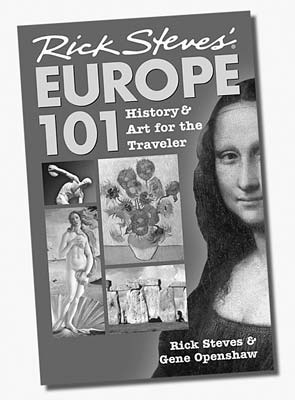
Video: My public television series, Rick Steves’ Europe, covers European destinations in 100 shows, with four episodes on Ireland. To watch episodes, visit www.hulu.com; for scripts and local airtimes, see www.ricksteves.com/tv.
Audio: My weekly public radio show, Travel with Rick Steves, features interviews with travel experts from around the world. All of this audio content is available at Rick Steves Audio Europe, an extensive online library organized by destination. Choose whatever interests you, and download it for free via the Rick Steves Audio Europe smartphone app, www.ricksteves.com/audioeurope, iTunes, or Google Play.
The black-and-white maps in this book are concise and simple, designed to help you locate recommended places and get to local TIs, where you can pick up more in-depth maps of towns or regions (usually free). Better maps are sold at newsstands and bookstores. Before you buy a map, check that it has the level of detail you want.
Train travelers do fine with a simple rail map (available as part of the free Intercity Timetable found at Irish train stations) and city maps from the TI offices. (You can get free maps of Dublin and Ireland from Tourism Ireland before you go; see “Tourist Offices” at the beginning of this chapter.) If you’re driving, get a road atlas that covers all of Ireland. Ordnance Survey atlases are best and available only once you reach Ireland (€10 in TIs, gas stations, and bookstores). Drivers, hikers, and cyclists may want more detailed maps for Dingle, Connemara, Donegal, Wexford, the Antrim Coast, the Ring of Kerry, and the Valley of the Boyne (easy to buy locally at TIs).
If you’re like most travelers, this book is all you need. But if you’re heading beyond my recommended destinations, $50 for extra maps and books can be money well spent.
Racks of fine guidebooks are sold at bookstores throughout Ireland and in the US, and each place you will visit has plenty of great little guidebooks to fill you in on local history. Especially for several people traveling by car, the extra weight and expense are negligible. Note that most of the following guidebooks are not updated annually; check the publication date before you buy.
For cultural and sightseeing background in bigger chunks, Michelin and Cadogan guides to Ireland are good. The Lonely Planet and Let’s Go books on Ireland are fine budget-travel guides—Lonely Planet’s guidebook is more thorough and informative; Let’s Go Ireland is youth-oriented, with good coverage of nightlife, hostels, and cheap transportation deals. Also consider Culture Shock: Ireland and Living Abroad in Ireland, especially if you’ll be in the Emerald Isle for an extended stay.
To learn more about Ireland past and present, check out a few of these books or films:
Nonfiction
For a quick overview, Richard Killeen’s A Short History of Ireland is a well-illustrated walk through key events. Ireland: A Concise History (Máire and Conor Cruise O’Brien) is just that, while How the Irish Saved Civilization (Thomas Cahill) shows how this “island of saints and scholars” changed the course of world history. In Traveller’s History of Ireland, Peter Neville leads readers on a tour through Ireland’s complicated history.
Frank McCourt’s autobiography, Angela’s Ashes, recounts his impoverished childhood in 1930s Limerick. Are You Somebody? The Accidental Memoir of a Dublin Woman (Nuala O’Faolain) and To School Through the Fields (Alice Taylor) are well-written memoirs. Two New Yorkers move to a tiny Irish village in O Come Ye Back to Ireland (first in a series of four books by Niall Williams and Christine Breen). For a humorous jaunt through the Irish countryside, read Round Ireland with a Fridge (Tony Hawks) or The Back of Beyond: A Search for the Soul of Ireland (James Charles Roy).
Fiction
Ireland is the home to its share of great writers, among them masters such as James Joyce (try his Dubliners for a look at Irish life in the 1900s), Oscar Wilde, Jonathan Swift, W. B. Yeats, George Bernard Shaw, and Samuel Beckett. Other classic Irish authors include Brendan Behan, Oliver Goldsmith, Thomas Kinsella, and Seamus Heaney (for more on Irish literature, see here).
Edward Rutherfurd’s thick, two-part Dublin Saga traces key events in Irish history from A.D. 430 to the fight for independence. Other historical epics include Trinity (Leon Uris), The Last Prince of Ireland (Morgan Llywelyn), and Ireland (Frank Delaney).
The Bódhran Makers (John B. Keane) is a heartwarming look at poor families in 1950s Ireland. Roddy Doyle’s gritty novels, such as The Barrytown Trilogy and A Star Called Henry, capture the day-to-day life of working-class Dubliners. Also set in Dublin, Finbar’s Hotel and Ladies’ Night at Finbar’s Hotel (Dermot Bolger) were written collaboratively, with each chapter penned by a different modern Irish author. Consider also any of Maeve Binchy’s soapy novels such as Circle of Friends.
Films
The Quiet Man (1952), starring John Wayne as a disgraced boxer, remains a sentimental favorite. David Lean’s epic WWI love story Ryan’s Daughter (1970) was filmed near Dingle. If you’re visiting the Aran Islands, Man of Aran (1934) is a classic documentary about the life of the island’s people in the early 20th century (see here for more details). For hard-hitting drama, see The Field (1991, an Irish farmer fights to keep his land) or Angela’s Ashes (1999, based on the Frank McCourt memoir). In Evelyn (2002), single-dad Pierce Brosnan goes to court to keep his kids. Unwed mothers struggle to survive an abusive 1960s nunnery in The Magdalene Sisters (2003).
For insight into the struggle for independence from Britain, see Michael Collins (1996, Liam Neeson), a biopic about the Irish Free State revolutionary, and The Wind That Shakes the Barley (2006), told through the story of two brothers. Odd Man Out (1947) is a film noir about the early IRA, with a great scene filmed in Belfast’s Crown Bar. The Troubles haunt a widow and her lover in Cal (1984). In the Name of the Father (1993, Daniel Day-Lewis) is a biopic of accused bomber Gerry Conlon. The families of IRA hunger strikers are the focus of Some Mother’s Son (1996), while the documentary-like Omagh (2004) recounts a deadly 1998 IRA bombing. In Fifty Dead Men Walking (2008), an IRA informer navigates the brutal world of the Troubles.
Equally bleak but worthwhile films include My Left Foot (1989), which garnered an Academy Award for Daniel Day-Lewis, and Veronica Guerin (2003), in which Cate Blanchett exposes drug lords as a journalist.
For a fun, throwaway romance, try Far and Away (1992), with Tom Cruise and Nicole Kidman as penniless Irish immigrants. For a comedic break, watch at least one of the films adapted from books by Roddy Doyle: The Commitments (1991), The Snapper (1993), or The Van (1996). In Waking Ned Devine (1998), a deceased villager wins the lottery (it’s funnier than it sounds). Children bring Irish folk tales to life in Into the West (1993) and The Secret of Roan Inish (1995). Leap Year (2009), with Amy Adams, was filmed on Inishmore (which was confusingly called Dingle in the film).
This list includes selected festivals in major cities, plus national holidays observed throughout Ireland in 2014. Many sights and banks close down on national holidays—keep this in mind when planning your itinerary. Before planning a trip around a festival, verify its dates by checking the festival’s website or TI site (www.discoverireland.com). For sports events, see www.sportsevents365.com for schedules and ticket information.
| Jan 1 |
New Year’s Day (banks closed) |
| Jan 22-26 |
Temple Bar Trad, Dublin (Irish music and culture festival, http://templebartrad.com) |
| March 14-17 |
St. Patrick’s Day celebration throughout Ireland (parades, drunkenness, 4-day festival in Dublin, www.stpatricksday.ie) |
| April 18 |
Good Friday (banks closed) |
| April 20-April 21 |
Easter Sunday and Monday |
| Late April |
International Pan Celtic Festival (festival in Derry in 2014 and 2015, www.panceltic.ie) |
| May 5 |
Labor Day; Early May Bank Holiday, Ireland and UK (banks closed) |
| June 2 |
Spring Bank Holiday, UK (banks closed); also June Holiday, Ireland (banks closed) |
| June 16 |
Bloomsday, Dublin (James Joyce festival, www.jamesjoyce.ie) |
| July 12 |
Battle of the Boyne anniversary, Northern Ireland (Protestant marches, protests) |
| Mid- to late July |
Galway Arts Festival (www.galwayartsfestival.com) |
| Late July-early Aug |
Galway Races (horse races, www.galwayraces.com) |
| Aug 4 |
August Bank Holiday, Ireland (banks closed) |
| Early Aug |
Dingle Races (horse races, www.dingleraces.ie) |
| Early-Mid-Aug |
Dingle Regatta (boat races) |
| Aug 10-12 |
Puck Fair, Killorglin, Kerry (“Ireland’s Oldest Fair” and drink-fest, www.puckfair.ie) |
| Aug 15 |
Kenmare Fair (www.kenmare.com) |
| Mid-Aug |
Féile an Phobail, West Belfast (Irish cultural festival, www.feilebelfast.com) |
| Aug 25 |
Late Summer Bank Holiday, UK only (banks closed) |
| Late Aug |
Rose of Tralee International Festival (http://roseoftralee.ie) |
| Late Aug-Early Sept |
Blessing of the Boats, Dingle (maritime festival) |
| Mid-Sept |
Galway Races (www.galwayraces.com) |
| Late Sept |
Galway Oyster Festival (4 days, www.galwayoysterfest.com) |
| Oct 27 |
October Bank Holiday, Ireland (banks closed) |
| Late Oct |
Galway Races (www.galwayraces.com) |
| Late Oct-Early Nov |
Belfast Festival at Queen’s (www.belfastfestival.com) |
| Dec 25 |
Christmas holiday, Ireland and UK |
| Dec 26 |
St. Stephen’s Day, Ireland (religious festival); Boxing Day, UK |
| Dec 31 |
New Year’s Eve |
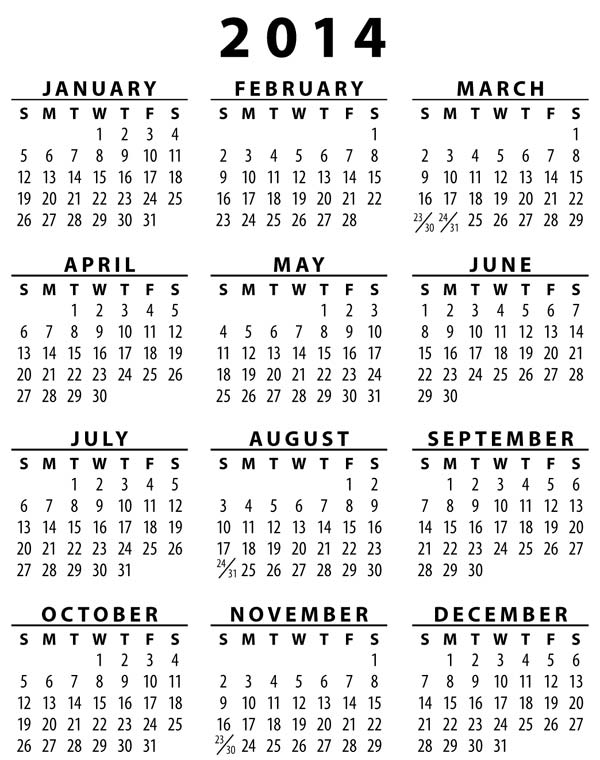
• In Europe, dates appear as day/month/year, so Christmas is 25/12/14.
• What Americans call the second floor of a building is the first floor in Europe.
• On escalators and moving sidewalks, Europeans keep the left “lane” open for passing. Keep to the right.
Both the Republic of Ireland and Northern Ireland use the metric system for everything but driving measurements. Weight and volume are typically calculated in metric: A kilogram is 2.2 pounds, and a liter is about a quart. The weight of a person is measured by “stone” (one stone equals 14 pounds). Temperatures are generally given in both Celsius and Fahrenheit.
On the road, the Republic of Ireland is still converting from miles to kilometers, and you’ll likely see signs in both (especially in rural destinations). Northern Ireland uses miles and posts speed limits in miles per hour.
1 foot = 0.3 meter
1 yard = 0.9 meter
1 mile = 1.6 kilometers
1 centimeter = 0.4 inch
1 meter = 39.4 inches
1 kilometer = 0.62 mile
1 square yard = 0.8 square meter
1 square mile = 2.6 square kilometers
1 ounce = 28 grams
1 quart = 0.95 liter
1 kilogram = 2.2 pounds
32°F = 0°C
When shopping for clothing, use these US-to-Ireland comparisons as general guidelines (but note that no conversion is perfect).
• Women’s dresses and blouses: Add 4
(US women’s size 10 = Ireland size 14)
• Men’s suits and jackets: US and Ireland use the same sizing
• Men’s shirts: US and Ireland use the same sizing
• Women’s shoes: Subtract 2½ (US size 8 = Ireland size 5½)
• Men’s shoes: Subtract about ½ (US size 9 = Ireland size 8½)
First line, average daily high; second line, average daily low; third line, average days without rain. For more detailed weather statistics for destinations in this book (as well as the rest of the world), check www.wunderground.com.
Ireland uses both Celsius and Fahrenheit to take its temperature. For a rough conversion from Celsius to Fahrenheit, double the number and add 30. For weather, remember that 28°C is 82°F—perfect. For health, 37°C is just right.
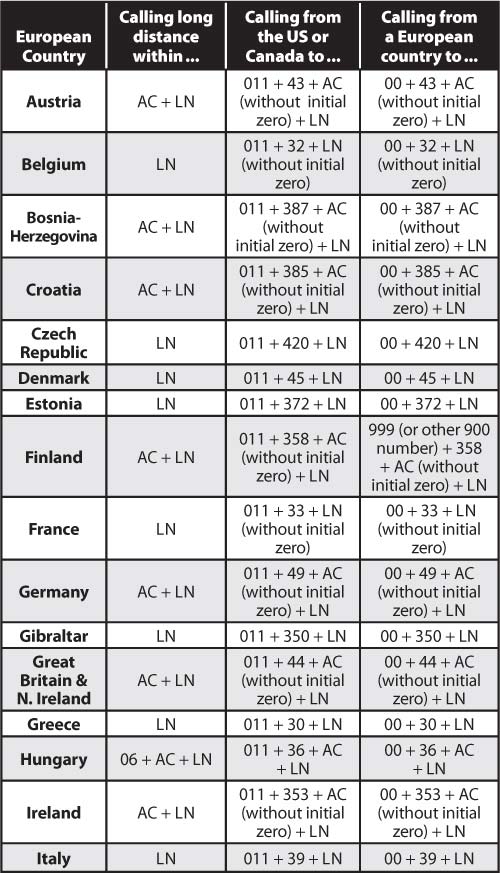
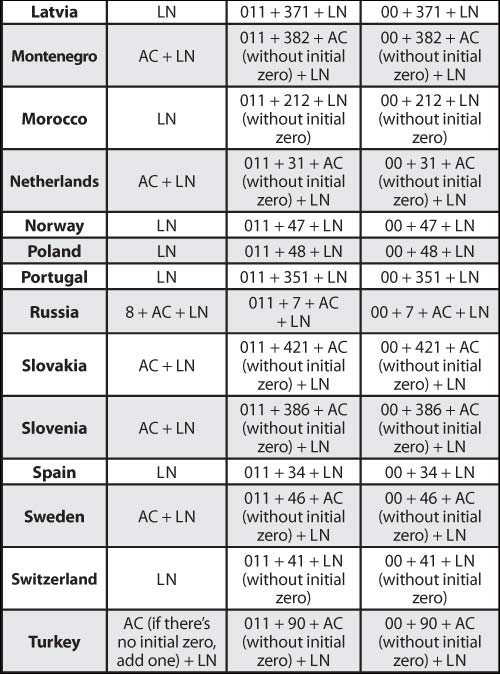
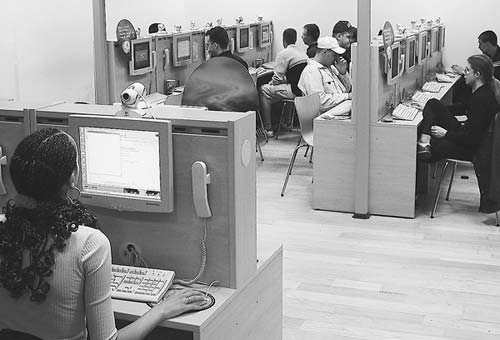
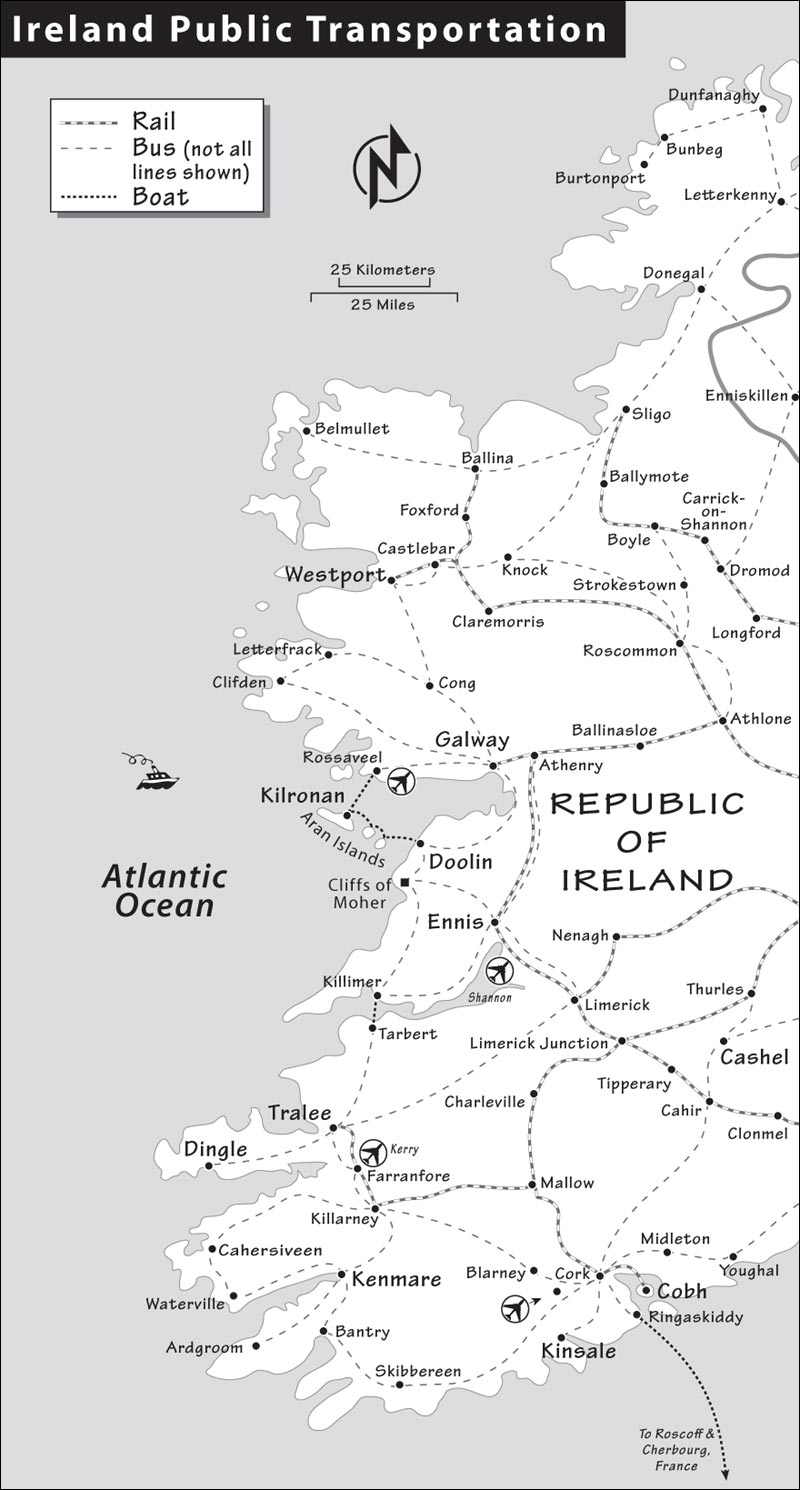
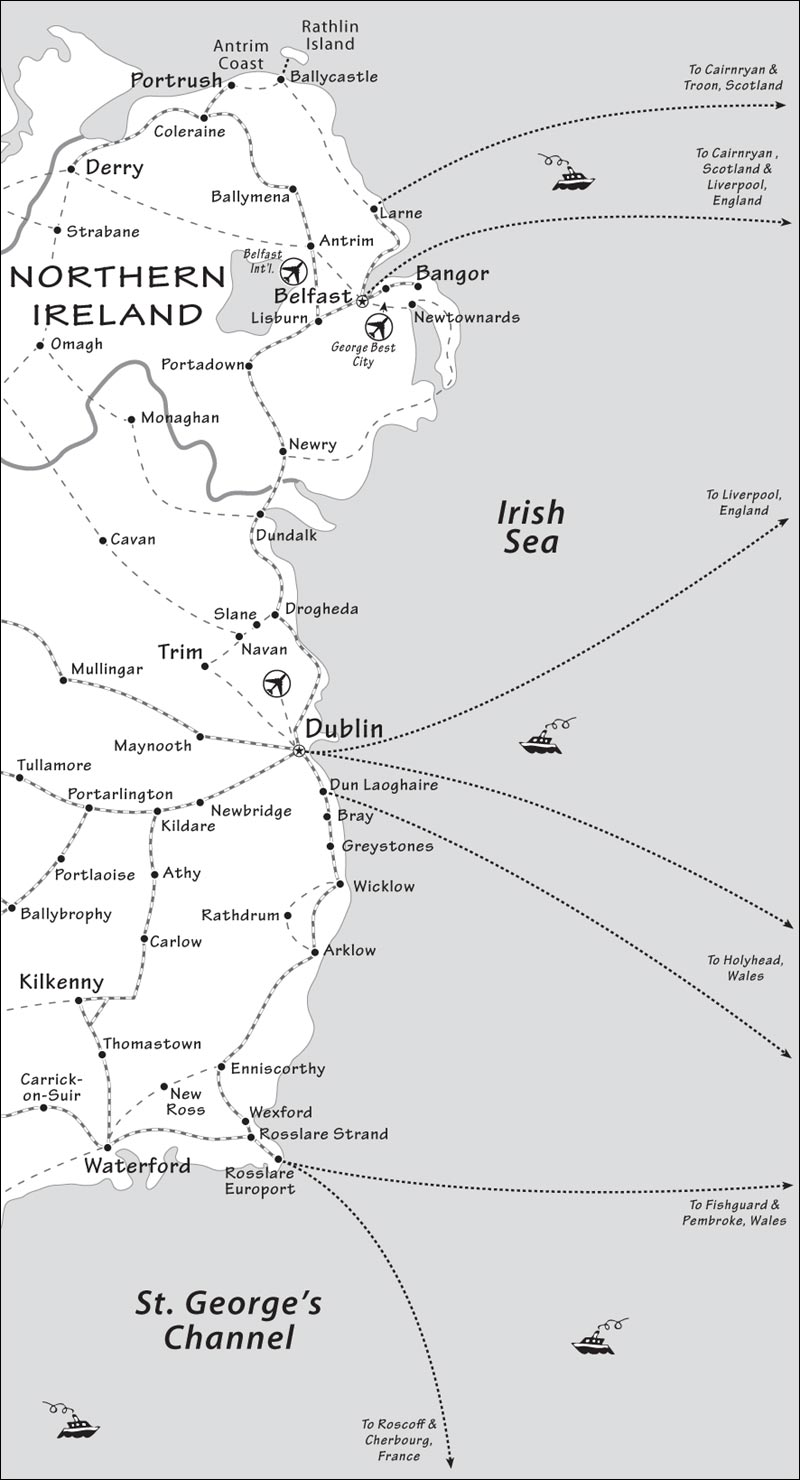
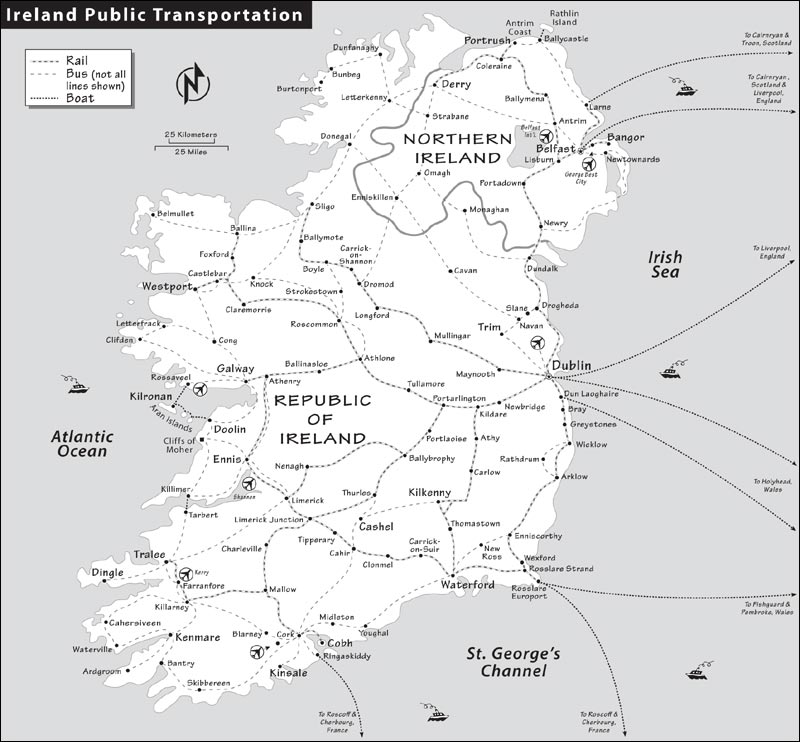
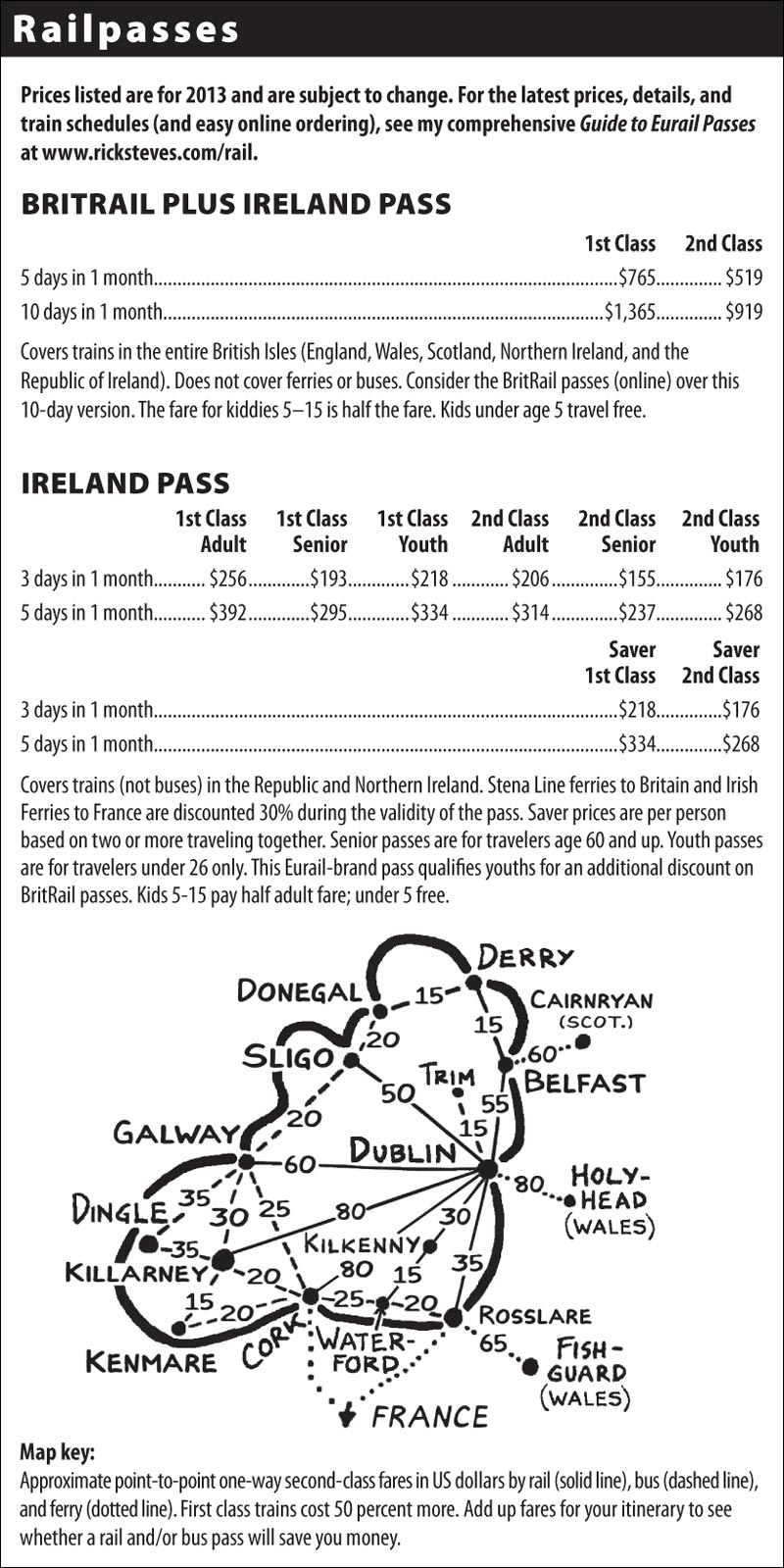

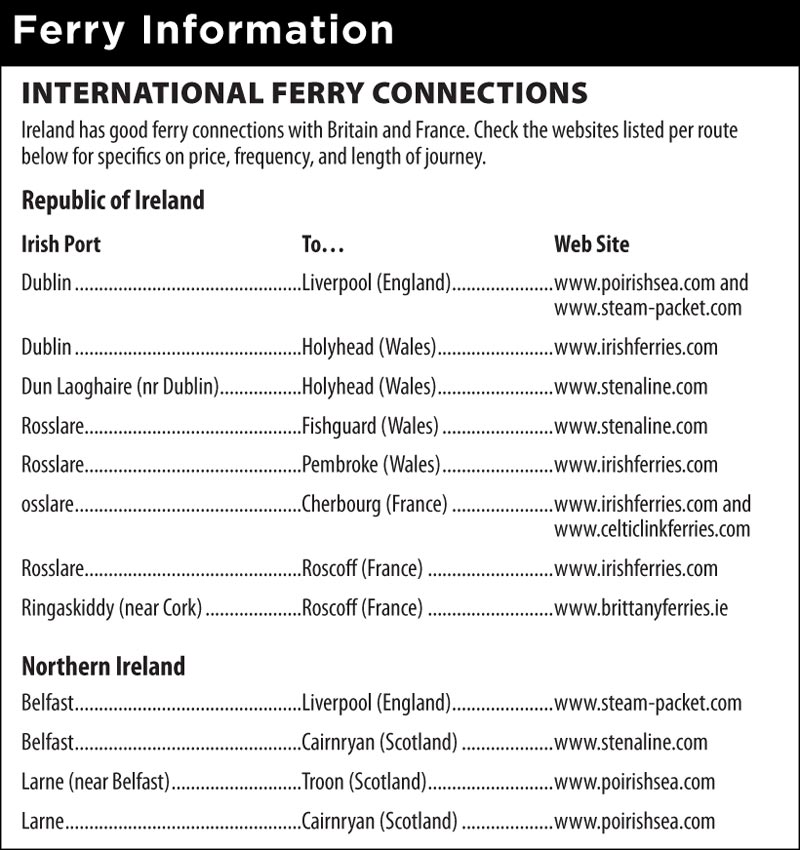
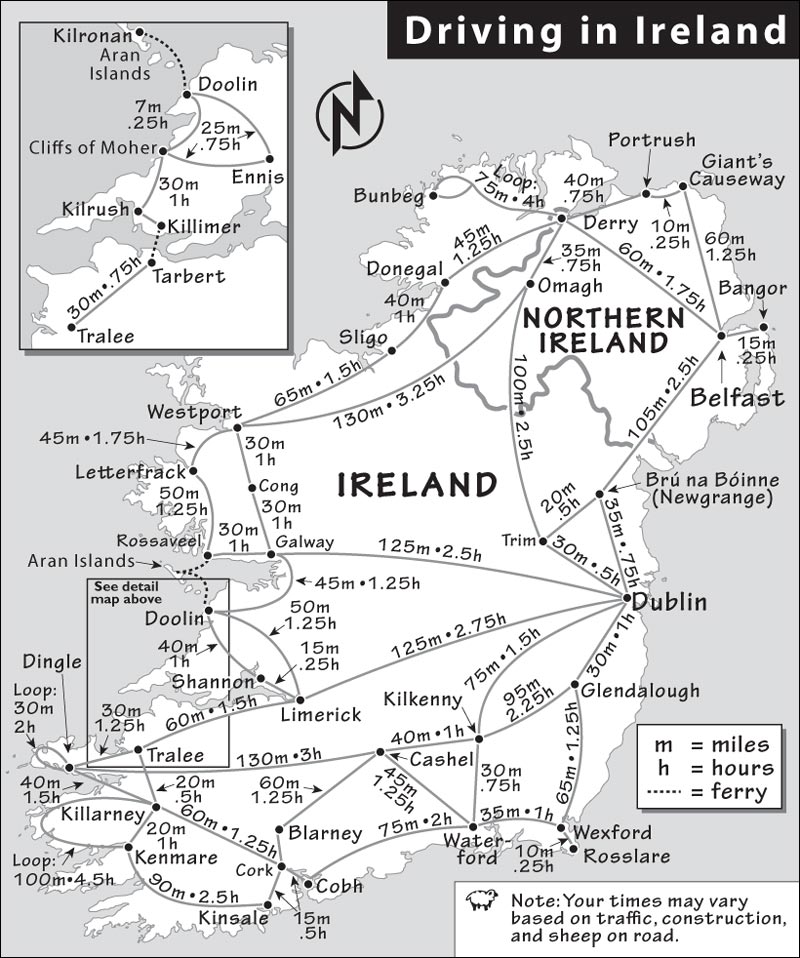
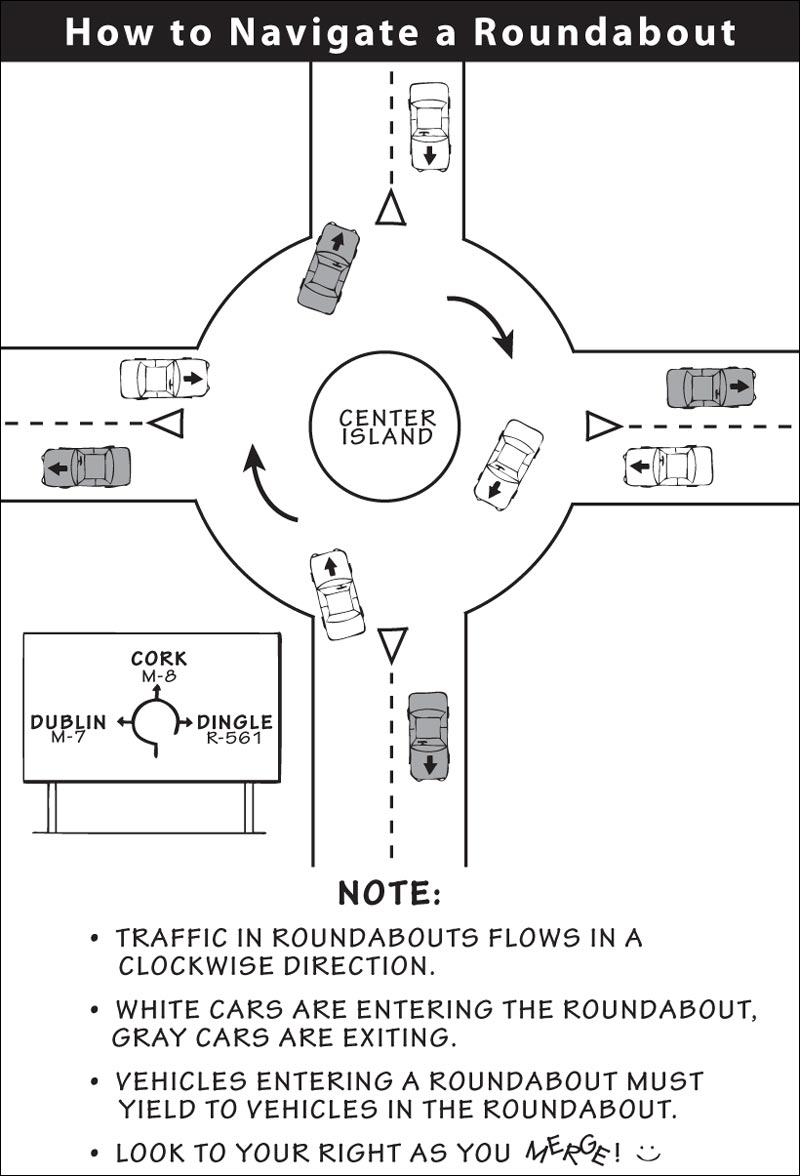
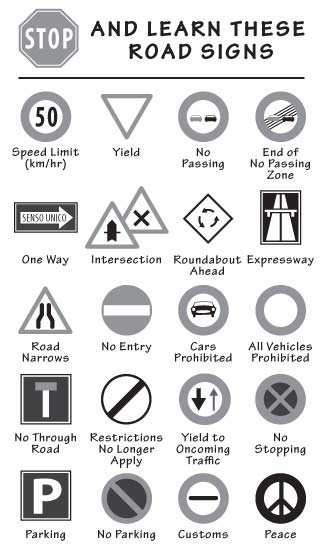
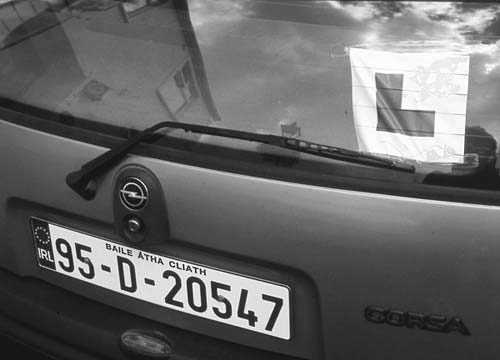
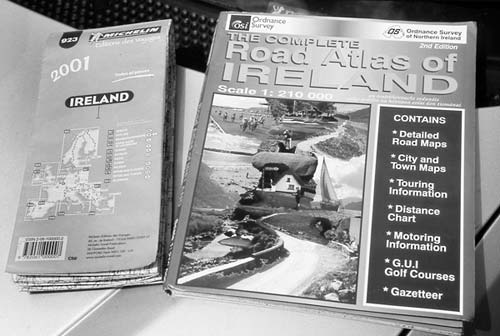
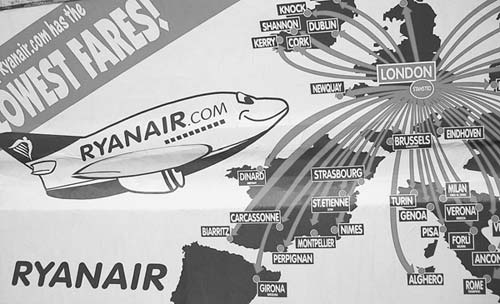

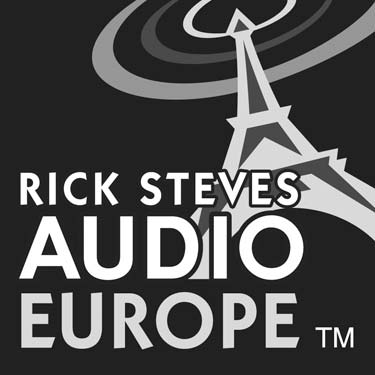


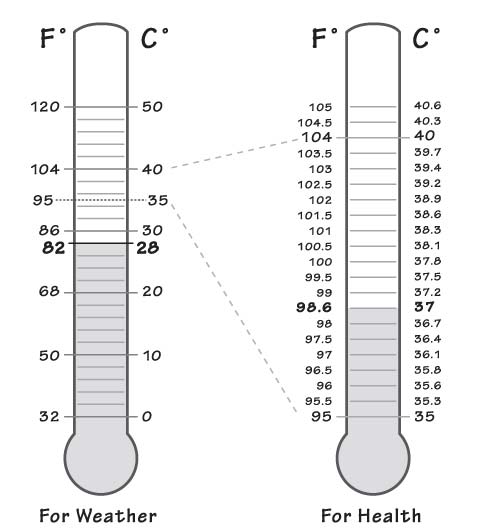
 5 shirts: long- & short-sleeve
5 shirts: long- & short-sleeve